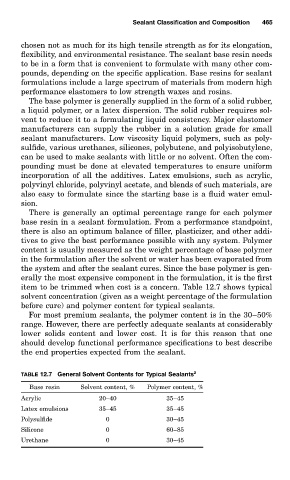Page 540 - Handbook of Adhesives and Sealants
P. 540
Sealant Classification and Composition 465
chosen not as much for its high tensile strength as for its elongation,
flexibility, and environmental resistance. The sealant base resin needs
to be in a form that is convenient to formulate with many other com-
pounds, depending on the specific application. Base resins for sealant
formulations include a large spectrum of materials from modern high
performance elastomers to low strength waxes and rosins.
The base polymer is generally supplied in the form of a solid rubber,
a liquid polymer, or a latex dispersion. The solid rubber requires sol-
vent to reduce it to a formulating liquid consistency. Major elastomer
manufacturers can supply the rubber in a solution grade for small
sealant manufacturers. Low viscosity liquid polymers, such as poly-
sulfide, various urethanes, silicones, polybutene, and polyisobutylene,
can be used to make sealants with little or no solvent. Often the com-
pounding must be done at elevated temperatures to ensure uniform
incorporation of all the additives. Latex emulsions, such as acrylic,
polyvinyl chloride, polyvinyl acetate, and blends of such materials, are
also easy to formulate since the starting base is a fluid water emul-
sion.
There is generally an optimal percentage range for each polymer
base resin in a sealant formulation. From a performance standpoint,
there is also an optimum balance of filler, plasticizer, and other addi-
tives to give the best performance possible with any system. Polymer
content is usually measured as the weight percentage of base polymer
in the formulation after the solvent or water has been evaporated from
the system and after the sealant cures. Since the base polymer is gen-
erally the most expensive component in the formulation, it is the first
item to be trimmed when cost is a concern. Table 12.7 shows typical
solvent concentration (given as a weight percentage of the formulation
before cure) and polymer content for typical sealants.
For most premium sealants, the polymer content is in the 30–50%
range. However, there are perfectly adequate sealants at considerably
lower solids content and lower cost. It is for this reason that one
should develop functional performance specifications to best describe
the end properties expected from the sealant.
TABLE 12.7 General Solvent Contents for Typical Sealants 2
Base resin Solvent content, % Polymer content, %
Acrylic 20–40 35–45
Latex emulsions 35–45 35–45
Polysulfide 0 30–45
Silicone 0 60–85
Urethane 0 30–45

